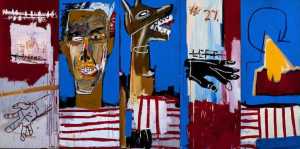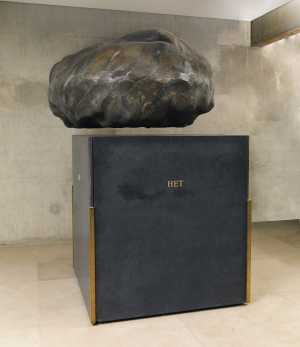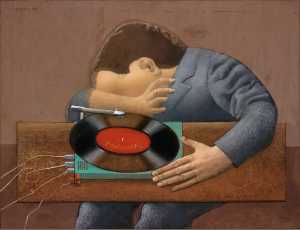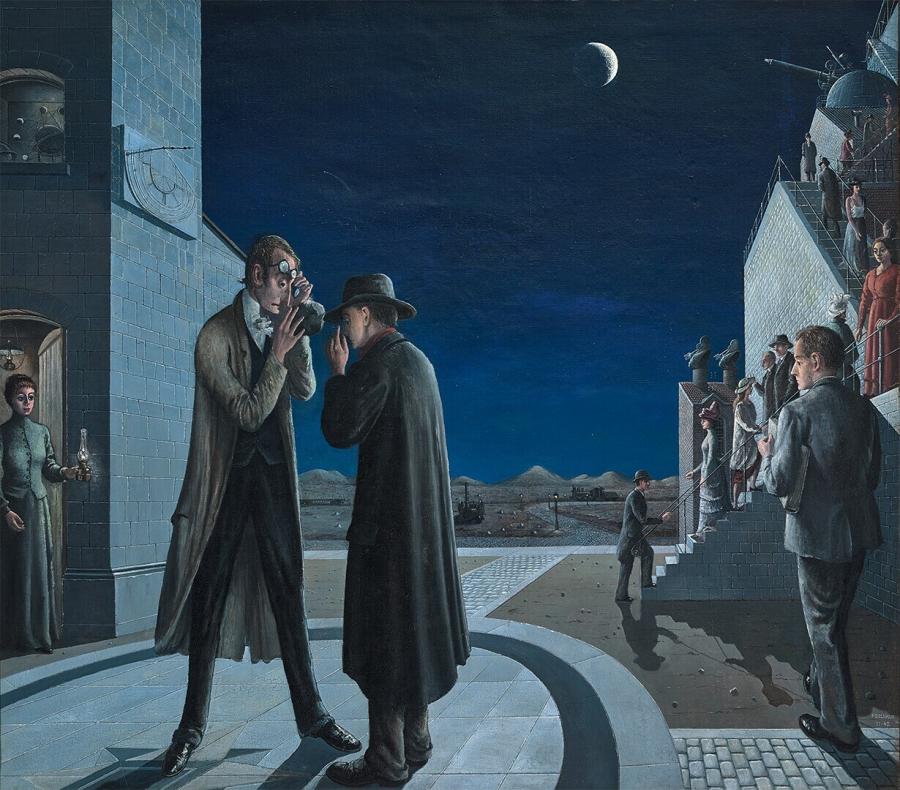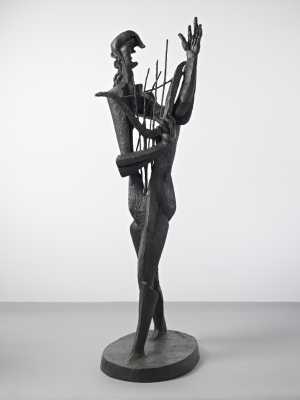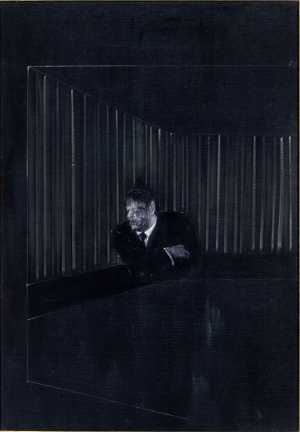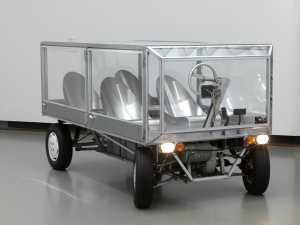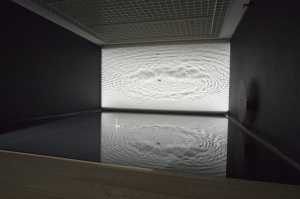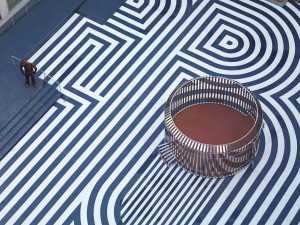Two educated men are standing on a square between two scientific institutes: left, a planetarium and right an observatory. The scene is lit by moonlight and breaths a cold atmosphere. The men and women walk up and down the steep stairway to the planetarium like marionettes. The barren landscape, with discarded heavy machinery, contributes to the atmosphere. The educated men are viewed by Paul Delvaux, who portrayed himself on the right as a passer-by.

Specifications
| Title | Les phases de la lune III |
|---|---|
| Material and technique | Oil on canvas |
| Object type |
Painting
> Painting
> Two-dimensional object
> Art object
|
| Location | This object is in storage |
| Dimensions |
Height 155 cm Width 175 cm |
|---|---|
| Artists |
Artist:
Paul Delvaux
|
| Accession number | St 132 |
| Credits | Loan Stichting Museum Boijmans Van Beuningen, 1973 |
| Department | Modern Art |
| Acquisition date | 1973 |
| Creation date | in 1942 |
| Entitled parties | © Fondation Paul Delvaux, St. Idesbald/Belgium, c/o Pictoright Amsterdam, 2018 |
| Provenance | Gustave van Geluwe, Ukkel 1942-62; A. Van Geluwe 1962-73; Museum Boijmans Van Beuningen Foundation 1973 |
| Exhibitions | Brussels 1944-45; Verviers/Düsseldorf/Otterlo/Ostend/Antwerp 1956; Rotterdam 1973a; Rotterdam 1996a; Ostend 1996-97; Brussels 1997; Venice 2000; Arnhem 2013-14; Rotterdam 2017b |
| Internal exhibitions |
The Collection Enriched (2011) De collectie als tijdmachine (2017) Collectie - surrealisme (2017) |
| External exhibitions |
De Melancholieke Metropool: stadsbeelden tussen magie en realisme, 1925-1950 (2013) A Surreal Shock – Masterpieces from Museum Boijmans Van Beuningen (2021) Dal nulla al sogno (2018) Only the Marvelous is Beautiful (2022) Surrealist Art - Masterpieces from Museum Boijmans Van Beuningen (2021) Dalí, Magritte, Man Ray and Surrealism. Highlights from Museum Boijmans Van Beuningen (2023) A Surreal Shock. Masterpieces from Museum Boijmans Van Beuningen (2023) |
| Research |
Show research A dream collection - Surrealism in Museum Boijmans Van Beuningen |
| Literature | Rotterdam 1973a, p. 126, cat. no. 23; Butor, Clair, Hubart-Wilkin 1975, p. 196, cat. no. 121; Emerson 1985, p. 103; Munich 1989, pp. 66-67, cat. no. 12; Sojcher 1991, pp. 27-29, fig. 41; Scott 1992, pp. 57-59 |
| Material | |
| Object | |
| Geographical origin | Belgium > Western Europe > Europe |
Do you have corrections or additional information about this work? Please, send us a message
Entry catalogue A dream collection - Surrealism in Museum Boijmans Van Beuningen
Author: Marijke Peyser
The Exposition Minotaure group exhibition was staged in the Palais des Beaux-Arts in Brussels in the spring of 1934. Prominent Surrealists, including Giorgio de Chirico, Salvador Dalí, Max Ernst, Alberto Giacometti, Man Ray and Yves Tanguy, were represented with works there.[1] Paul Delvaux visited the exhibition and was moved by De Chirico’s paintings: ‘De Chirico’s deserted towns, his silent figures made an impression on me because I felt that all this satisfied something within me… that everything is poetry, it is a totally poetic programme’.[2] In Delvaux’s works after 1934 women, alone or in a group, naked or veiled in classical clothing, are the main motif. They are silent, sometimes they look at one another, almost always they seem to be in a trance. They are located in an alienating setting, often a deserted urban landscape. The dream-like beings have blonde hair, huge dark eyes, big breasts and black pubic hair. Sometimes they are accompanied by clothed or naked men or a skeleton.
Delvaux did not think of himself as a Surrealist. He dismissed the Surrealists’ automatism and rejected the social revolution of André Breton and his writings.[3] It is true that Delvaux’s works have a dream-like character with their nocturnal settings and hushed figures, but the images – stations, ancient buildings and the reclining Venus figure – do not directly refer to Surrealism. All the same, art historians generally consider him part of the Belgian Surrealist movement because of his participation in a number of important Surrealist exhibitions and his contacts with key figures like E.L.T. Mesens and René Magritte.
Between 1939 and 1942 Delvaux painted three versions of Les phases de la lune. The key figure in the three paintings is a man with a magnifying glass, Professor Otto Lidenbrock, the geologist in Jules Verne’s Journey to the Centre of the Earth (1864) who searches for the origins of the universe. In a letter to the journalist and Verne specialist Pierre-André Touttain, the painter explained the presence of this scholar in his oeuvre: ‘I was fascinated by the fantastic journey to the centre of the universe and the rather comical personality of the professor. I already thought that the picture of the professor examining a geode was engaging when I was ten years old. At that time I copied Riou’s illustration and pinned it on the wall of my room.’[4] Édouard Riou’s illustrations would also be an important source of inspiration for later paintings.
In the first version of Les phases de la lune, which dates from 1939, Lidenbrock studies a fossil. A voluptuous woman, her breasts covered by a large pink bow, who sits opposite him on a balcony, fails to attract his attention. In the background a procession of naked women walk by, led by a young man. In the second version (1941) we are in a room. A naked woman stares straight ahead and once again the professor’s attention is on the fossil. In the background on the left a group of men converse. Scientific attributes are evidence of their interests. The door of the room is wide open, giving a view of a petrified, dead landscape. In all three works a waxing or waning moon can be seen in the background.
Footnotes
[1] During the opening André Breton gave a lecture on Surrealism entitled ‘Qu’est-ce que le surréalisme?’
[2] Emerson 1985, p. 61.
[3] Rotterdam 1973a, p. 18.
[4] Sojcher 1991, p. 27 and note 77 refer to this letter from Delvaux, dated 19 July 1970, published in ‘Le Cahier Jules Verne’, ed. De l’Herne 1974, p. 108.
All about the artist
Paul Delvaux
Antheit 1897 - Veurne 1994
Paul Delvaux studied at the Academy of Fine Arts in Brussels. His first paintings were strongly influenced by the Flemish expressionism of Gustave de Smet and...
Bekijk het volledige profiel

